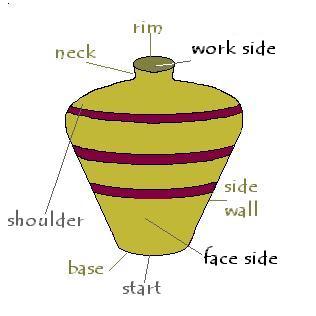 a.
the start,
a.
the start,Basketry
I. What is a basket?
1. Definition: a semi-rigid container made by connecting at least two perpendicularly-crossing lengths of flexible materials.
A. Basket vocabulary:
 a.
the start,
a.
the start,
b. the base - flat, hemispherical, footed, pointed, absent,
c. walls - straight-sided, conical, globular, shouldered, or absent.
d. rim- self-finished, reinforced.
e. warp (structure) and weft (skin); may be warp-faced, weft-faced or balanced.
f. work side and face side.
B. Shapes are round, oval, square or mixed and depend on use.
2. Function range:
A. Transportation of loads and people.
a. boats, cradles, burden baskets.
B. Caching water and personal object
a. sometimes coated with pitch or asphaltum (tar) to make a looser weave watertight.
C. Gifts.
D. Trade and sale,
a. always a treasure, never a currency.
E. Food preparation, serving, and storage,
a. the vast majority used here.
F. Traps and weirs.
G. Protective clothing,
a. armor, sandals, and hats.
H. Game trays.
I. Commemorative pieces.
J. Housing.
3. Division of labor in basket making
A. Propagation
a. by individuals but usually a group or family activity,
b. men, women, and youths participate depending on crop.
B. Gathering
a. by individuals but usually a group or family activity,
b. man may gather while woman splits withes.
C. Preparation.
a. individuals at home or work site but may occur in groups.
b. usually prepared by maker, but not always.
D. Execution - some general rules.
a. made by individuals at home or at work sites,
b. finer examples usually made by woman, but not always,
c. traps, weirs, and rough ware usually made by men.
4. Design, technique and materials.
A. Design and form
a. dependent on
i. materials available and social acceptability.
aa. not every group uses every basket plant.
ii. cultural attitudes about tradition and innovation.
aa. not many valued innovation.
iii. intended function of the basket.
aa. throw away or gift.
iv. manufacture technique
aa. design may appear on face only or both surfaces.
b. often named for a natural scene they graphically represent,
i. quail top-knot, footprints leading to water, Milky Way.
c. often achieved by use of color.
B. Techniques
a. Coiling
i. weft faced or balanced weave,
ii. design appears on inside and outside surfaces.
b. Twining
i. usually weft faced or balanced weave,
ii. wicker work is a type of weft-faced twining,
iii. 19 types known world wide,
iv. design may appear on face only.
c. Plaiting
i. always exactly opposite on front and back face.
C. Materials use - almost 2,000 plants good for basket making yet people use only a few types.
a. Selection depends on
i. environment - yucca or baleen,
ii. cultural attitudes about tradition and innovation,
iii. intended functions.
D. An important status maker for women
a. opportunity for women to get recognition in a culture where other individual achievement (like hunting) was down-played in favor of the group.
b. Open competions between basketmakers. Some with big prize money and all with status.
c. Some women, like Louisa Keyser (Dat So La Lee) achieved acclaim among Westerners and used their fame to establish basket making cooperatives, saying they made each and every basket that passed through the cooperative to get higher prices for all women in the community.
Now, follow this link to the Phoebe Apperson Hearst Museum at UC Berkeley and see what their basket collection holds.